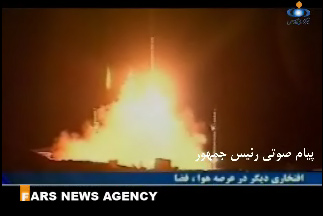Iran Launches Observation Satellite: Reports

Iran launched its second-ever domestically built satellite into orbit Wednesday (June 15), according to media reports.
The satellite, known as Rasad-1 (Observation-1), blasted off Wednesday aboard an Iranian-made Safir rocket, the nation's official Islamic Republic News Agency said. According to IRNA, Rasad-1 will be used for peaceful purposes, mapping and monitoring the Earth from an altitude of 162 miles (260 kilometers).
"Rasad satellite’s mission is establishing contact with Earth stations, obtaining orders from those stations, image taking from the Earth and dispatching those images along with telemetry information back to the Earth stations," IRNA reported.
However, the launch is sure to raise concerns in the West that Iran is ramping up its space capabilities for military purposes. The same rockets that can launch satellites, after all, could theoretically be used to fire warheads, as the Associated Press notes.
Officials in the United States, Israel and other Western nations suspect Iran is trying to develop nuclear weapons, a charge the Islamic Republic denies. Its nuclear program, Iran says, is for power generation only. [Top 10 Space Weapons]
Rasad-1 weighs about 34 pounds (15.3 kilograms), IRNA reported. Its launch comes two years after the liftoff of Iran's first homegrown satellite, Omid (Hope), which took to the skies in February 2009.
Iran's fledgling space program has made other notable strides recently. Just this past March, for example, the nation launched a new rocket and space capsule designed to carry a monkey into orbit, according to IRNA.
Breaking space news, the latest updates on rocket launches, skywatching events and more!
That test flight apparently carried no live animals, but in February 2010 Iran launched a rat, two turtles and a worm on its Kavoshgar-3 rocket, the nation said.
Ultimately, Iran has said it aims to launch a human into space by 2020 and to put an astronaut on the moon by 2025. The Islamic republic denies military motives for its space program, but its desire to be a major player in space is plain.
Today's "successful launching of Rasad is another long stride towards fixing the presence of the Islamic Republic of Iran in the space," IRNA reported.
You can follow SPACE.com senior writer Mike Wall on Twitter: @michaeldwall. Follow SPACE.com for the latest in space science and exploration news on Twitter @Spacedotcom and on Facebook.

Michael Wall is a Senior Space Writer with Space.com and joined the team in 2010. He primarily covers exoplanets, spaceflight and military space, but has been known to dabble in the space art beat. His book about the search for alien life, "Out There," was published on Nov. 13, 2018. Before becoming a science writer, Michael worked as a herpetologist and wildlife biologist. He has a Ph.D. in evolutionary biology from the University of Sydney, Australia, a bachelor's degree from the University of Arizona, and a graduate certificate in science writing from the University of California, Santa Cruz. To find out what his latest project is, you can follow Michael on Twitter.
